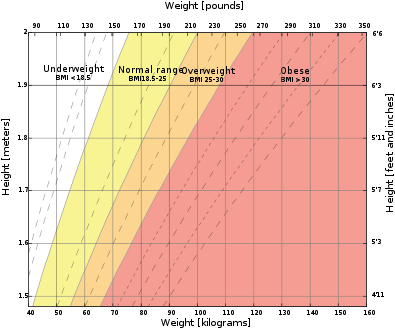10 Signs of Weight Gain

Vanity sizing—also known as size inflation—refers to the practice of making clothes of a nominal size larger over the years. For example, a woman who used to wear a size 12 might now fit into a size 10 or even a size 8. This practice is used as a marketing tool to help customers feel better about themselves.
While vanity sizing might work in the fashion industry, the real world isn’t always so accommodating of our broadening waistlines. Here are 10 real-world signs that we’ve gained a few extra pounds over the years:
1. Ferries: In 2011, the Washington state ferry system reduced the passenger capacity of its ferries in response to Coast Guard stability rules raising the estimated weight of the average adult from 160 to 185 pounds. A ferry which used to carry up to 2000 passengers now carries only 1750.
Body Mass Index (BMI)
BMI is a proxy for human body fat based on a person's weight and height.
BMI = (Mass (lb) / Height (in)²) x 703

2. Ambulances: Boston spent $12,000 to retrofit each of its ambulances to handle larger patients. The stretchers used by those ambulances cost $8,000 each and can handle up to 850 pounds. Fort Worth spent $7,000 to retrofit each of its ambulances, and bought stretchers with a weight limit of 650 pounds to replace older stretchers with a limit of only 500 pounds.
3. Weight Scales: Siltec Scales has found a new market for its line of industrial and shipping scales: personal users who need a weight scale with a capacity above 350 pounds. For example, Siltec’s PS500L scale provides accurate measurements in 0.5 pound increments up to 500 pounds.
4. Elevators: In 2010, Mitsubishi installed a gigantic elevator in Osaka, Japan with a capacity of 80 Japanese passengers. If, however, this elevator were to be installed in the United States, it could safely accommodate only 65 American passengers with its capacity of 11,574 pounds.
5. Buses: The Federal Transit Administration has proposed new bus testing regulations to more accurately reflect today’s passengers. The proposals reflect an increase in average weight from 150 to 175 pounds; an increase in average floor space occupied by a standing passenger from 1.5 to 1.75 square feet, and updated methods to test bus structural strength and stability.
6. Car Seats: The National Highway Traffic Safety Administration is aware of its need to develop a lifelike crash test dummy for use in testing car seats for children weighing more than 65 pounds. Car seat manufacturers are now marketing harnesses for children weighing up to 85 pounds.
7. Airlines: If a Southwest Airlines staff member determines a passenger will not fit in one seat, the passenger will need to purchase a second seat, but will receive a refund if the flight is not full. The airline uses the armrests for its 17-inch wide seats to gauge this need. Per Southwest: “Customers who are unable to lower both armrests and/or who encroach upon any portion of the adjacent seat should proactively book the number of seats needed prior to travel.”
8. Hospitals: Hospitals are increasing their purchases of medical devices and equipment to service their obese patients. Hospital tables capable of supporting patients up to 600 pounds patient cost up to $30,000, while tables for patients up to 1000 pounds cost up to $45,000. Other plus-sized purchases include hospital beds, wheelchairs, stretchers, walkers and blood-pressure cuffs.
9. Lethal Injection: The state of Ohio may need a new way to execute its prisoners on death row. An inmate scheduled to be executed by lethal injection has asked a federal judge to delay his execution because, at a weight of over 480 pounds, his executioners may find it too difficult to inject the single dose of pentobarbital into his arms, as called for by Ohio’s death penalty law.
10. Furniture: The market for bariatric furniture is currently estimated at $400 million, and is expected to grow rapidly. Bariatric weight load is typically between 500 and 700 pounds, although customers can find furniture rated for loads of over 1000 pounds. Because this furniture tends to be expensive due to the structural demands but is not covered by insurance, manufacturers often target customers aged 40 to 59, with a BMI over 30, and an income of at least $50,000.
Statistics from the American Heart Association
Sobering facts from the American Heart Association's 2012 Statistical Fact Sheet:
Adults:
149.3 million Americans age 20 or older are overweight or obese (BMI of 25 and higher).
Of these American adults, 75.0 million are obese (BMI of 30 and higher).
Children:
About 1 in 3 children ages 2 through 19 are overweight or obese (BMI-for-age at or above 85 percentile of the 2000 CDC growth charts).
About 1 in 6 children ages 2 through 19 are obese (BMI-for-age at or above 95th percentile of the 2000 CDC growth charts).
Costs:
Total healthcare costs due to obesity could reach $861 to $957 billion by 2030 if current trends continue. This would represent 16% - 18% of total US healthcare expenditures.
Total excess costs attributable to childhood obesity and overweight is an estimated $254 billion.









